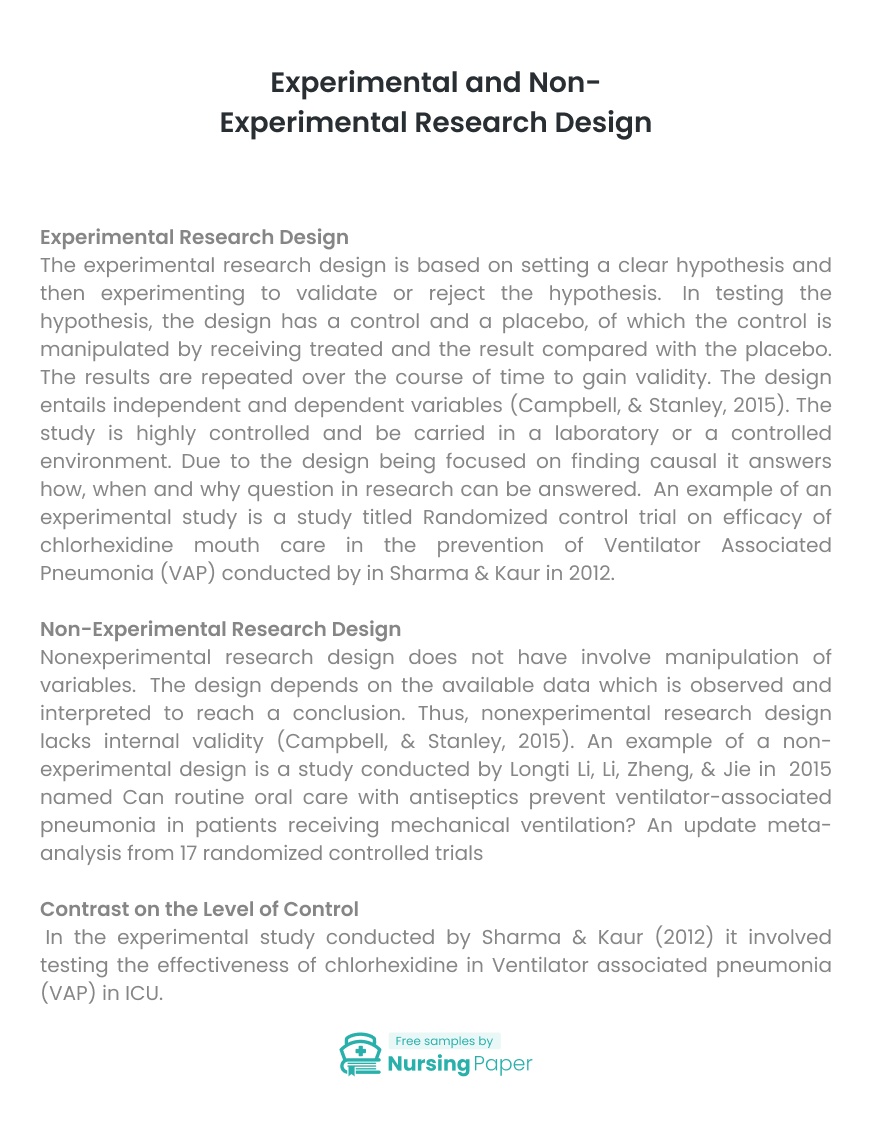
Experimental and Non-Experimental Research Design
Experimental Research Design
The experimental research design is based on setting a clear hypothesis and then experimenting to validate or reject the hypothesis. In testing the hypothesis, the design has a control and a placebo, of which the control is manipulated by receiving treated and the result compared with the placebo. The results are repeated over the course of time to gain validity. The design entails independent and dependent variables (Campbell, & Stanley, 2015). The study is highly controlled and be carried in a laboratory or a controlled environment. Due to the design being focused on finding causal it answers how, when and why question in research can be answered. An example of an experimental study is a study titled Randomized control trial on efficacy of chlorhexidine mouth care in the prevention of Ventilator Associated Pneumonia (VAP) conducted by in Sharma & Kaur in 2012.
Non-Experimental Research Design
Nonexperimental research design does not have involve manipulation of variables. The design depends on the available data which is observed and interpreted to reach a conclusion. Thus, nonexperimental research design lacks internal validity (Campbell, & Stanley, 2015). An example of a non-experimental design is a study conducted by Longti Li, Li, Zheng, & Jie in 2015 named Can routine oral care with antiseptics prevent ventilator-associated pneumonia in patients receiving mechanical ventilation? An update meta-analysis from 17 randomized controlled trials


Contrast on the Level of Control
In the experimental study conducted by Sharma & Kaur (2012) it involved testing the effectiveness of chlorhexidine in Ventilator associated pneumonia (VAP) in ICU. The experiment was carried out from August to December in the year 2010. The randomized control trial involved 230 patients of which 130 were given chlorhexidine, and the rest used the normal oral care. The results showed a reduction in the case of VAP for the patients that used VAP as compared to the normal oral care by a ratio by 5.7% and 35.4% respectively. It was therefore recommended that the method was effective.
On the other hand, the nonexperimental study conducted by is Longie, Li, Zheng, & Jie (2015) involved meta-analysis of randomized controlled trial by a search of scientific peer-reviewed articles in the three databases namely PubMed, Web of Science and Embase. The research journal which met the research criteria were critically appraised. These articles showed that chlorhexidine was effective in reduction of VAP in critically ill patient. Markedly, this was based on the statistical analysis of the results of the randomized controlled trials.
As it can be depicted above, the experimental study involved full control of the variables while in the non-experimental study the research had no control of the data and depended on observation and analysis.

1. Campbell, D. T., & Stanley, J. C. (2015). Experimental and quasi-experimental designs for research. Ravenio Books.
2. Longti Li, Z. A., Li, L., Zheng, X., & Jie, L. (2015). Can routine oral care with antiseptics prevent ventilator-associated pneumonia in patients receiving mechanical ventilation? An update meta-analysis from 17 randomized controlled trials. International journal of clinical and experimental medicine, 8(2), 1645.
3. Sharma, S. K., & Kaur, J. (2012). Randomized control trial on efficacy of chlorhexidine mouth care in prevention of Ventilator Associated Pneumonia (VAP). Nursing and Midwifery Research, 8(2).



The download will start shortly.

The download will start shortly.
 Subject:
Nursing
Subject:
Nursing  Number of pages: 5
Number of pages: 5  Subject:
Medicine
Subject:
Medicine  Number of pages: 5
Number of pages: 5  Subject:
Nursing
Subject:
Nursing  Number of pages: 3
Number of pages: 3  Subject:
Health and Social Care
Subject:
Health and Social Care  Number of pages: 10
Number of pages: 10  Subject:
Health and Social Care
Subject:
Health and Social Care  Number of pages: 5
Number of pages: 5  Subject:
Nursing
Subject:
Nursing  Number of pages: 2
Number of pages: 2  Subject:
Nursing
Subject:
Nursing  Number of pages: 2
Number of pages: 2  Subject:
Health and Social Care
Subject:
Health and Social Care  Number of pages: 10
Number of pages: 10  Subject:
Nursing
Subject:
Nursing  Number of pages: 3
Number of pages: 3  Subject:
Health and Social Care
Subject:
Health and Social Care  Number of pages: 7
Number of pages: 7  Subject:
Health and Social Care
Subject:
Health and Social Care  Number of pages: 9
Number of pages: 9  Subject:
Health and Social Care
Subject:
Health and Social Care  Number of pages: 2
Number of pages: 2  Subject:
Nursing
Subject:
Nursing  Number of pages: 3
Number of pages: 3  Subject:
Health and Social Care
Subject:
Health and Social Care  Number of pages: 4
Number of pages: 4  Subject:
Nursing
Subject:
Nursing  Number of pages: 2
Number of pages: 2 
